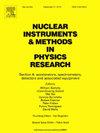Novel ideas for CMS L1 trigger in HL-LHC using RPC ultimate timing performance
IF 1.5
3区 物理与天体物理
Q3 INSTRUMENTS & INSTRUMENTATION
Nuclear Instruments & Methods in Physics Research Section A-accelerators Spectrometers Detectors and Associated Equipment
Pub Date : 2025-04-17
DOI:10.1016/j.nima.2025.170477
引用次数: 0
Abstract
The CMS RPC system has been upgraded for Phase-2 with two major projects. First is the comprehensive redesign of the Link System connecting the Front-End Boards (FEBs) of existing CMS RPC chambers to the trigger processors, which leads to the full exploitation of the intrinsic time resolution of 1.6 ns. Second is the extension of the pseudorapidity coverage by adding new chambers from = 1.9 to 2.4. The newly assembled chambers utilize improved Resistive Plate Chambers (iRPC) technology, enabling signal readout from both ends of the strip for 2-dimensional hit reconstruction. Equipped with advanced electronics, iRPCs deliver hit timing with a 500 ps resolution, facilitating the development of precise Time of Flight triggers. We will discuss algorithms in which RPCs can be used as a starting point for new physics searches, given the vital role of RPC in the CMS experiment, specifically upgraded to cope with high luminosity and high number of simultaneous proton–proton collisions per bunch crossing (also called pileup) expected in the upcoming High-Luminosity Large Hadron Collider (HL-LHC) phase. We aim at improving the detection efficiency of Long-lived particles (LLPs), offering a tantalizing glimpse into new physics, potentially providing clues about beyond-the-Standard-Model theories. The focus will be on one type of LLPs, the heavy stable charged particles (HSCPs) that leave traces in the muon chambers as if they were muons but with a time delay. The ultimate time resolution performance of existing RPCs and iRPCs will enhance the discovery potential of our searches in CMS for new physics.
利用RPC最终定时性能实现HL-LHC中CMS L1触发的新思路
CMS RPC系统已经升级为第二阶段的两个主要项目。首先,对连接现有CMS RPC室的前端板(feb)到触发处理器的链路系统进行了全面的重新设计,从而充分利用了1.6 ns的固有时间分辨率。二是通过增加新的腔室,从|η| = 1.9扩大到2.4,扩大了伪快度覆盖范围。新组装的腔室利用改进的电阻板腔(iRPC)技术,可以从条带的两端读取信号,用于二维撞击重建。配备了先进的电子设备,irpc提供500 ps分辨率的命中定时,促进了精确飞行时间触发器的开发。考虑到RPC在CMS实验中的重要作用,我们将讨论RPC可以用作新物理搜索起点的算法,特别是升级以应对即将到来的高亮度大型强子对撞机(HL-LHC)阶段预计的高亮度和高数量的每束交叉同时发生的质子-质子碰撞。我们的目标是提高长寿命粒子(llp)的探测效率,提供对新物理学的诱人一瞥,可能为超越标准模型的理论提供线索。重点将放在一种类型的llp上,重稳定带电粒子(hscp),它们在μ子腔中留下痕迹,就好像它们是μ子一样,只是有时间延迟。现有rpc和irpc的最终时间分辨率性能将增强我们在CMS中搜索新物理的发现潜力。
本文章由计算机程序翻译,如有差异,请以英文原文为准。
求助全文
约1分钟内获得全文
求助全文
来源期刊
CiteScore
3.20
自引率
21.40%
发文量
787
审稿时长
1 months
期刊介绍:
Section A of Nuclear Instruments and Methods in Physics Research publishes papers on design, manufacturing and performance of scientific instruments with an emphasis on large scale facilities. This includes the development of particle accelerators, ion sources, beam transport systems and target arrangements as well as the use of secondary phenomena such as synchrotron radiation and free electron lasers. It also includes all types of instrumentation for the detection and spectrometry of radiations from high energy processes and nuclear decays, as well as instrumentation for experiments at nuclear reactors. Specialized electronics for nuclear and other types of spectrometry as well as computerization of measurements and control systems in this area also find their place in the A section.
Theoretical as well as experimental papers are accepted.

 求助内容:
求助内容: 应助结果提醒方式:
应助结果提醒方式:


